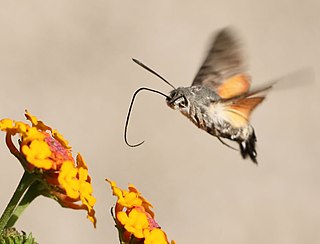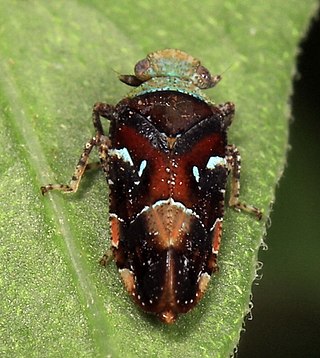
Delphacidae is a family of planthoppers containing about 2000 species, distributed worldwide. Delphacids are separated from other "hoppers" by the prominent spur on the tibia of the hindleg.

Ricaniidae is a family of planthopper insects, containing over 400 species worldwide. The highest diversity is in tropical Africa and Asia and in Australia, with a few species occurring in the Palearctic and Neotropical realms. It is one of the smaller families in the planthopper superfamily Fulgoroidea.

Rhodoprasina is a genus of moths in the family Sphingidae erected by Walter Rothschild and Karl Jordan in 1903.

Macroglossini is a tribe of moths of the family Sphingidae described by Thaddeus William Harris in 1839.

Cercopidae are the largest family of Cercopoidea, a xylem-feeding insect group, commonly called froghoppers or spittlebugs. They belong to the hemipteran suborder Auchenorrhyncha. A 2023 phylogenetic study of the family suggested the elevation of subfamily Ischnorhininae to full family status as Ischnorhinidae, leaving a monophyletic Cercopinae.

Flatidae are a family of fulgoroid planthoppers. They are cosmopolitan in distribution and are distinguished from others in the superfamily by a combination of characters. Like all other planthoppers, they suck phloem sap of plants. Some species are known to communicate with vibrations through the plant stems. Communication may be with mates, or with ants that tend the nymphs, protecting them and gathering honeydew secretions. Adults of some species have brightly coloured forewings which are tougher and known as tegmina unlike the membranous hindwings which are used for flight. Although a few can be identified by their coloration, most species requires dissection and examination under a microscope with access to literature on already described species.
Oryxa is a genus of planthoppers in the hemipteran family Flatidae. They live on the islands of Borneo and Sumatra, and in Malaysia.

Issidae is a family of planthoppers described by Spinola in 1839, belonging to the order Hemiptera, suborder Auchenorrhyncha superfamily Fulgoroidea.
Ujna is a genus of leafhoppers belonging to the family Cicadellidae, subfamily Mileewinae. They are known from India, Madagascar and Seychelles.

Lepyronia is a genus of froghoppers in the family Aphrophoridae.

Gergithus is a genus of tropical Asian planthoppers in the family Issidae, erected by Carl Stål in 1870. Like all planthoppers, adults feed on plant sap and are capable of escaping by leaping. The genus like other members in the tribe appears somewhat rounded and beetle-like, in some cases, with a mimetic resemblance to ladybird beetles. Species are mostly distributed in the Indomalayan Realm.

Aphrophora is a genus of spittlebugs in the family Aphrophoridae. There are at least 80 described species in Aphrophora.

Delphacinae is a subfamily of delphacid planthoppers in the family Delphacidae. There are at least 1,700 described species in Delphacinae.

Dictyopharinae is a subfamily of dictyopharid planthoppers in the family Dictyopharidae. There more than 100 genera and 500 described species in Dictyopharinae.

Meenoplidae is a family of fulgoromorph planthoppers that are closely related to the Kinnaridae. They are small, with tent-like wings and usually are less than a centimetre long and a little more than a 100 species in around 25 genera are known with a distribution restricted to the Old World. They are distinguished by having one or more of their claval veins covered in sensory pits along their length. The face is usually broad and the lateral carinae are strongly elevated. The last segment of the labium is elongate. A median ocellus is usually present. The wings are always present in adults and the venation consists of a small number of veins and very few cross veins. There are two subfamilies currently considered valid Meenoplinae and Kermesiinae. About 50 species are known from Africa. Along with the Achilixiidae and Kinnaridae, they have flattened star-shaped plate organs on their antennae. The nymphs are found close to the soil while adults feed mainly on monocots. Species identity can usually be established reliably only by examination of the male genitalia. A few species Phaconeura pluto, Meenoplus cancavus, Tsingya clarkei, and Suva oloimoa are known to be cave dwelling.

The Tettigometridae are a family of Fulgoromorpha (planthoppers), with an Old World species distribution.

The Hemisphaeriinae are a subfamily of bugs in the family Issidae, based on the type genus Hemisphaerius. Species in 119 genera have been recorded in most continents, but the greatest diversity appears to be in South-East Asia.
Doratura is a genus of true bugs belonging to the family Cicadellidae.
Neomelicharia is a genus of planthoppers belonging to the family Flatidae.
Tropidocephala is a genus of planthopper bugs, typical of the tribe Tropidocephalini. Species have been recorded from Africa, Europe and Asia.














